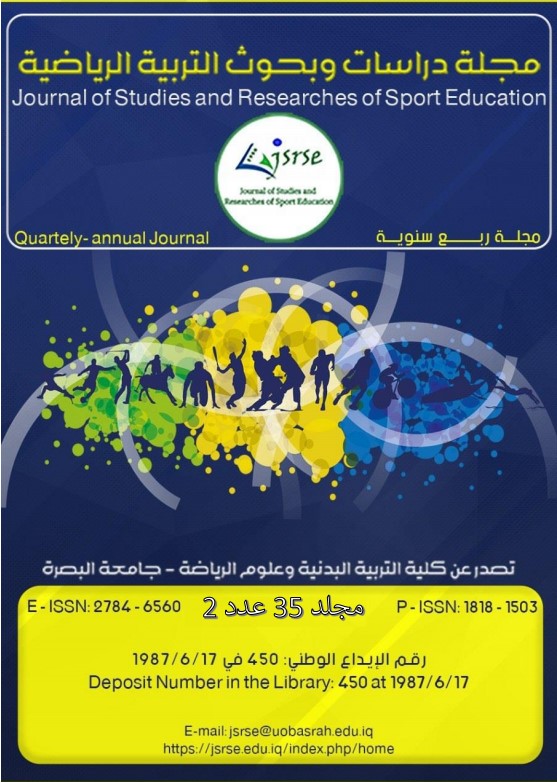دراسة تحليلية لاهم المتغيرات البايوكينماتيكية لمرحلة النهوض وعلاقتها بانسيابية الحركة لمهارة الضرب الساحق بالكرة الطائرة
محتوى المقالة الرئيسي
الملخص
هدف البحث التعرف على اهم المتغيرات البايوكينماتيكية لمرحلة النهوض عند اداء مهارة الضرب الساحق بالكرة الطائرة استعمل الباحثان المنهج الوصفي لمعالجة المشكلة اما عينة البحث فكانت لا عبي المنتخب الوطني بالكرة الطائرة واستنتج الباحثان ان انفراج زاوية الركبة لمرحلة النهوض يؤثر بشكل كبير على متغيرات الاداء البايوكينماتيكية لأنه يقلل من زمن النهوض ويحافظ على كمية الحركة المكتسبة من الاقتراب وكانت اهم التوصيات التأكيد على مرحلة النهوض لأهميتها الكبيرة واثرها على بقية المراحل عند اداء مهارة الضرب الساحق بالكرة الطائرة
تفاصيل المقالة

هذا العمل مرخص بموجب Creative Commons Attribution-NonCommercial 4.0 International License.
المراجع
Abdel, N. H. M. D. N., & Ali, Z. B. D. Q. M. (2014). The effect of using different resistors characteristic speed and power some variables Kinmatik and the achievement of the enemy 100 m. Journal of Studies and Researches of Sport Education, 41.
Bastawisi, A. (1996). Foundations and Theories of Movement (1st ed). Dar Al Fikr Al Arabi.
Eileen, W. F. (1990). Volleyball: A Guide for Teachers, Coaches and Players (p. 14). Dar Al Maaref.
Hajim, S. A. (1995). Analysis of the relationship between the kinematic and dynamic characteristic curve of the rise phase in the hopscotch and some biomechanical variables of the triple jump performance phase [PhD thesis]. University of Basra.
Hamad, S. H., Saad, H. M., Agam, B. I., & Farhan, M. K. (2024). THE EFFECT OF VISUAL TRACKING EXERCISES ON SOME MOVEMENT ABILITIES AND THE SKILL OF DEFENDING THE COURT IN VOLLEYBALL FOR STUDENTS. Proximus Journal of Sports Science and Physical Education, 1(7), 77–83.
Intisar, K. A. K. (2002). Kinetic analysis of some back flips in ground movements [Master’s thesis]. University of Baghdad.
Khalifab, M., & Jabbar, R. H. (2023). The effect of an electronic device designed to measure the degree of bending of the knee angle in developing the skill of catch and Clearance the high ball for football goalkeepers under (15 years). J Xi’an Shiyou Univ Nat Sci Ed, 19(11), 751–764.
Marwan, A. M. I. (2000). Descriptive and inferential statistics in the fields and research of physical education (1st edition). Dar Al-Fikr Al-Arabi.
Mashkoor, N. H. (2010). The relationship between the angle of departure from the starting support and the time of abandonment and the average speed of the first stage (speed increase). Journal of Studies and Researches of Sport Education, 27. https://www.iasj.net/iasj/article/53710
Mustafa, A. M., Mashkoor, N. H., & Qusay, M. A. (2010). The effect of the height and depth of the approximate run range on some kinematic variables of the long jump effectiveness. Journal of Studies and Researches of Sport Education, 28. https://www.iasj.net/iasj/article/53596
Oudah, A. Y., Diwan, L. H., & Shehab, S. G. (2022). The Effect Of The Interactive Blended Learning Strategy In Learning The Skill Of Crushing Hitting In Volleyball For Students. Journal of Positive School Psychology, 6(6).
Risan, K. M., & Najah, M. S. (2002). International Scientific House for Publishing and Distribution (p. 12). Publishing and Distribution.
Sameer, M. A.-H. (1999). Sports Biomechanics (p. 102). Dar Al-Kutub for Printing and Publishing.





 IASJ
IASJ CC-BY-4.0
CC-BY-4.0 turnitin
turnitin ISSN
ISSN DOAJ
DOAJ Crossref
Crossref GoogleScholar
GoogleScholar Orcid
Orcid